With functionality, affordability and applicability requirements causing a significant deficit of tools in the video laryngoscopy sector, airway management solution provider SmartBlade has developed a video laryngoscope to assist with the intubation of difficult airways.
“There is a great need for available laryngoscopes, as well as a need for more contextually relevant and applicable technology that can allow for best practice with a broader spectrum of use. It is also important to have technology that speaks specifically to the delivery of universal healthcare,” says SmartBlade co-founder and medical director Dr Caroline Corbett.
Corbett, together with SmartBlade co-founder and CEO Nick Nevin, believe in clinician-guided and human-centric solutions. The SmartBlade video laryngoscope was, therefore, developed to provide better, affordable and more accessible technology in the field of advanced airway management.
“A video laryngoscope is a tool that is placed into the mouth of a patient who is sedated or unconscious and, consequently, requires assistance with keeping their airways open. The ‘blade’ is the portion of the laryngoscope that is placed into the patient’s mouth to view the oropharynx or the laryngeal opening of the trachea. The tool uses indirect viewing of the larynx through a camera at the tip of the blade to enable the clinician to place a breathing or endotracheal tube for manual or assisted breathing of the patient,” Corbett informs.
SmartBlade uses a hyper-angulated patented design to allow for the best viewing of difficult airways and (anatomically) standard airways. A channelled design on the blade portion facilitates guided tube placement.
SmartBlade has replaced the costly portable screens usually used with the laryngoscope with smartphone connectivity that connects directly to the blade handle.
Moreover, the laryngoscope is unique in its suction and oxygenation port, which allows for a soiled airway to be suctioned during visualisation and tube placement. This is vital in clearing secretions away from the camera lens for optimal viewing and out of the laryngeal opening so it does not obstruct the lungs and airways.
This channel and port may also be alternatively connected to an oxygen source to provide apnoeic oxygenation during intubation.
It can also be used when acute allergic reactions occur and in cases of obstructive sleep apnoea, as these patients would be classed as having difficult airways.
The SmartBlade video laryngoscope is designed for use in all sectors, from resource-rich environments to rural areas where access to resources is limited.
“Rural clinics staffed by interns or community service doctors are supported through this device, as they are able to intubate patients even though there are no anaesthesiologists on site by using the intuitive software that enables telemedicine,” says Corbett.
Further, the application of the laryngoscope extends beyond the operating theatre and can be used in emergency rooms, casualty settings, in dental suits and even remote sites or military and field hospitals.
Moreover, the SmartBlade is priced so that end-user clinicians can buy it without relying on hospital groups, clinics or emergency services groups.
Additionally, Corbett informs that the SmartBlade is ideal for use during Covid-19 and, since the onset of the pandemic in South Africa, there has been an increase in orders for the SmartBlade video laryngoscope.
“Intubation of Covid-19 patients is one of the most high-risk times for clinicians and patients, as patients are sedated and there is a risk of the oxygen supply being lowered while intubating them. The clinician is also exposed to an aerosol-generating procedure while attempting to place the tube safely and successfully, which could expose them to the virus.
“By using the in-line suction while intubating the patient, the clinician can assist in suctioning away the aerosolised droplets emitted into the oropharynx and better protect themselves,” she says.
Corbett says that SmartBlade is an ideal solution from a cost, efficiency and ease-of-use perspective, particularly as South Africa lacks universal access to such equipment.
Edited by: Zandile Mavuso
Creamer Media Senior Deputy Editor: Features
EMAIL THIS ARTICLE SAVE THIS ARTICLE
ARTICLE ENQUIRY
To subscribe email subscriptions@creamermedia.co.za or click here
To advertise email advertising@creamermedia.co.za or click here













